TCD signs and symptoms
Identify tree as a walnut
TCD only affects walnut species. In Missouri, that means eastern black walnut and butternut. At first glance, trees such as pecan, tree-of-heaven, golden raintree and black locust can be mistaken for a black walnut tree. So, to begin, make sure your tree is a walnut. To identify a walnut tree, look for the following:
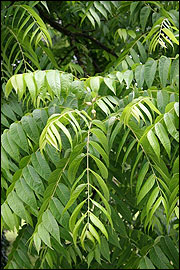
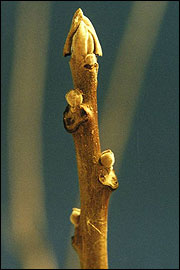

- Black walnut leaves (above left) are compound leaves, which is a group of leaflets joined by a stalk to a woody stem, 12 to 14 inches long with nine to 25 leaflets. Each leaflet is three to five inches longs with toothed margins. (Photo by Robert Videcki, Doronicum Kft., bugwood.org.)
- The compound leaves are arranged in an alternate fashion, spiraling around the twig (above center). (Photo by Bill Cook, Michigan State University, bugwood.org.)
- The overall lighter, yellow-green leaf color of black walnut (above right) makes it fairly distinguishable from the darker green foliage of our oaks and hickories. The invasive tree species tree-of-heaven is oftentimes mistaken for a walnut tree. But, it does not have the chocolate brown inner bark color of walnut. (Photo by Hank Stelzer, University of Missouri.)
Additional information on walnut identification
Symptoms
Symptoms are not visible until several years after initial attack by walnut twig beetles and might appear on several trees in an area.
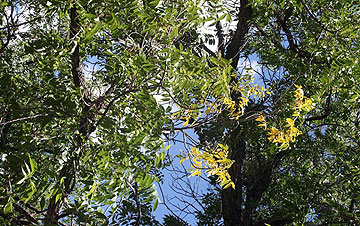 Early symptoms include mid-summer yellowing and wilting of foliage high in the crown. The limbs usually die back from the top downward. (Photo by Whitney Cranshaw, Colorado State University, bugwood.org.)
Early symptoms include mid-summer yellowing and wilting of foliage high in the crown. The limbs usually die back from the top downward. (Photo by Whitney Cranshaw, Colorado State University, bugwood.org.)
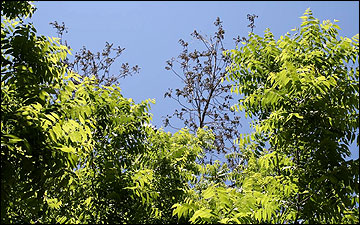 Limbs are killed with dead, wilted leaves attached. (Photo by Karen Snover-Clift, Cornell University, bugwood.org.)
Limbs are killed with dead, wilted leaves attached. (Photo by Karen Snover-Clift, Cornell University, bugwood.org.)
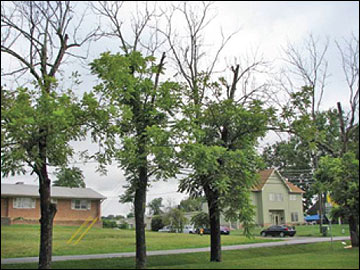 New sprouts might grow from roots or trunk below dead limbs. (Photo by Diane Warwick, Tennessee Division of Forestry.)
New sprouts might grow from roots or trunk below dead limbs. (Photo by Diane Warwick, Tennessee Division of Forestry.)
Signs
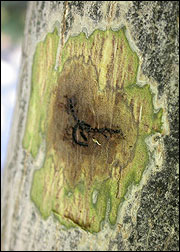 Removing bark from dying limbs 1 to 2 inches in diameter exposes dark brown cankers (areas of discolored tissue) around walnut twig beetle about the width of a pencil lead. Cutting more deeply into the wood of the tree removes evidence of cankers and beetle tunnels. (Photo by Ned Tisserat, Colorado State University, bugwood.org.)
Removing bark from dying limbs 1 to 2 inches in diameter exposes dark brown cankers (areas of discolored tissue) around walnut twig beetle about the width of a pencil lead. Cutting more deeply into the wood of the tree removes evidence of cankers and beetle tunnels. (Photo by Ned Tisserat, Colorado State University, bugwood.org.)
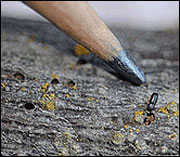 Walnut twig beetles are smaller than a grain of rice and difficult to find. (Photo by Kathy Keatley Garvey, University of California – Davis.)
Walnut twig beetles are smaller than a grain of rice and difficult to find. (Photo by Kathy Keatley Garvey, University of California – Davis.)
Disease progression
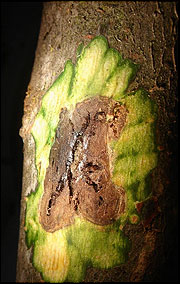

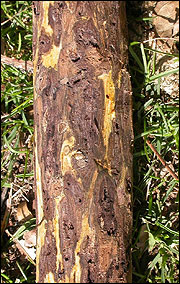
Thousand cankers disease gets its name from the multitude of cankers created by the repeated boring of a walnut twig beetle carrying the fungal spores. Although an individual canker is small in size, the sheer number of cankers overlap one another, and kill the tissues responsible for transporting water and food throughout the tree. (Photos by Curtis Utley and Ned Tisserat, Colorado State University, bugwood.org.)
Do not mistake the walnut twig beetle with other walnut wood boring insects
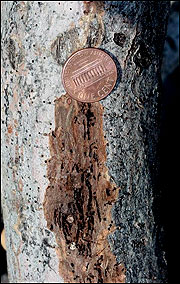
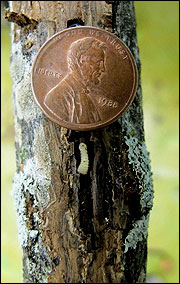 There are several native boring insects commonly found on stressed black walnut trees in Missouri. The walnut twig beetles (left) are smaller than the native boring insects (right). These native animals do not indicate TCD. (Photos by Whitney Cranshaw, Colorado State University, bugwood.org. and Robbie Doerhoff, Missouri Department of Conservation.)
There are several native boring insects commonly found on stressed black walnut trees in Missouri. The walnut twig beetles (left) are smaller than the native boring insects (right). These native animals do not indicate TCD. (Photos by Whitney Cranshaw, Colorado State University, bugwood.org. and Robbie Doerhoff, Missouri Department of Conservation.)
In addition, Missouri black walnut trees are occasionally affected by several other diseases and insects, especially on poor sites exposed to the severe 2012 drought.